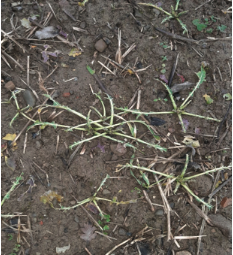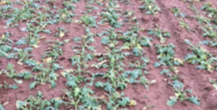We have accumulated significantly more rainfall this January compared with that of 2020 – 80.3ml vs 55.1ml. Where winter barley is sitting in waterlogged soils, there is a threat of tiller death.
 Research shows that this has a detrimental impact on yield, as energy is wasted on tillers that do not survive until harvest, which otherwise contribute to grain yield. This stress can also induce Ramularia, and with the recent loss of chlorothalonil, will be a harder disease to control down the road. Tillers are beginning to yellow, but this should green up again with warmer temperatures as it takes up mineralised nitrogen from the soil. A very low rate of Nitrogen applied in February can encourage backward crops to keep their tillers, maximising yield potential. Winter wheat crops are currently at GS 23, with the more vigorous varieties advancing to GS 24. The vernalisation period has passed, with the recent below-zero temperatures also reducing aphid activity. It should be noted that aphid eggs are extremely cold-tolerant, enabling them to over-winter and provide for a population of both winged and non-winged aphids at flowering. When weather permits, a herbicide application will be needed, contact your local Drummonds agronomists for further advice on this. Winter oats are becoming leggy, with the recent cold spells slowing growth, which is certainly welcome.
Research shows that this has a detrimental impact on yield, as energy is wasted on tillers that do not survive until harvest, which otherwise contribute to grain yield. This stress can also induce Ramularia, and with the recent loss of chlorothalonil, will be a harder disease to control down the road. Tillers are beginning to yellow, but this should green up again with warmer temperatures as it takes up mineralised nitrogen from the soil. A very low rate of Nitrogen applied in February can encourage backward crops to keep their tillers, maximising yield potential. Winter wheat crops are currently at GS 23, with the more vigorous varieties advancing to GS 24. The vernalisation period has passed, with the recent below-zero temperatures also reducing aphid activity. It should be noted that aphid eggs are extremely cold-tolerant, enabling them to over-winter and provide for a population of both winged and non-winged aphids at flowering. When weather permits, a herbicide application will be needed, contact your local Drummonds agronomists for further advice on this. Winter oats are becoming leggy, with the recent cold spells slowing growth, which is certainly welcome.
Oilseed rape crops in the North-East have been heavily grazed by pigeons, particularly in mid-January. However, plant counts remain intact, varying between 30 - 50 plants/m2. Oilseed rape has an excellent recovery ability, and will not be significantly affected by this grazing. In February, take a GAI (Green Area Index) score of your crop to assess for canopy size and subsequently, tailor crop nitrogen. A GAI of 1 – 1.5 in February is the target. Drummonds team of agronomists can provide further information on this. Taking control of your canopy size now is important, to achieve the optimum GAI index of 3.5 at flowering. This maximises yield potential, with the aim of achieving 100,000 seeds/ m2. In terms of weed control, volunteer cereals and grass weeds are prevalent where a pre-emergence spray such as Butisan S was avoided. A graminicide such as Falcon should be used in these situa- tions. Kerb Flo provides excellent grassweed control. For broadleaf weed control, Salsa has a broad spectrum of activity and should be used during active weed growth. Latest stage of application is at the 8-leaf stage.
ACT NOW BEFORE IT’S TOO LATE
Now is the last chance to get soil samples taken to tailor crop nutrition with requirements. Drummonds sustainable soil fertility programme takes care of soil sampling, interpreting the results and clearly explaining the results to its customers. A detailed fertiliser plan will be created specific to your farm.
NATIONAL RECOMMENDED LIST FOR SPRING CEREALS 2021
The national recommended list for spring cereals was released in January.
Spring Barley: There were no major changes compared to the 2020 list. Disease scores and variety characteristics remain unchanged. Limona has been removed for the 2021 provisional list. At Drummonds, we will be supplying Planet, Arderin and Highway.
Spring Wheat: KWS Chilham is no longer available, and has been removed for 2021. Talisker and Starlight will provide the majority of seed purchased, followed by Hexham which is provisionally recom- mended.
Spring Oats: Keely will not be available this year. Husky winter oats are highly available here at Drummonds.
Spring Beans: Lynx and Fanfare beans are available at Drummonds, which are used to boost the protein content of our coarse rations.
Spring Oilseed Rape: The recommended list for spring oilseed rape has not yet been released.
INDUSTRY NEWS
A new €10 million investment into the Irish tillage sector is welcomed for 2021 – the Straw Chopping Scheme (SCS). Farmers will be paid for chopping straw (excluding protein crops). While more detailed information is yet to be released about the scheme, we can start to think about the straw market for harvest 2021.Improving soil structure, the retention of carbon, improved soil biological activity and returning essential macronutrients such as phosphorous and potassium to the soil are major advantages of the scheme. Thus, a reduced cost of production can be availed of in the next growing season. With current expectations of 1 million 4x4 round bales of straw to return to our soils, it would be fair to assume a higher market price for straw, causing us to look the other way at the scheme. Only time will tell how this turns out.

